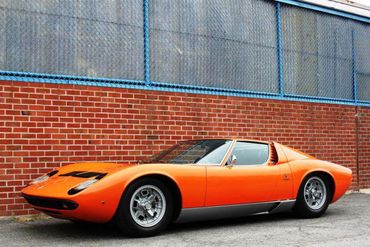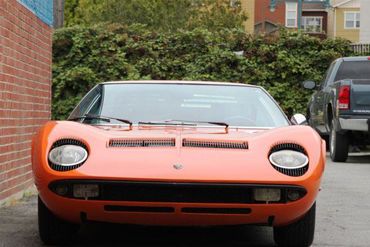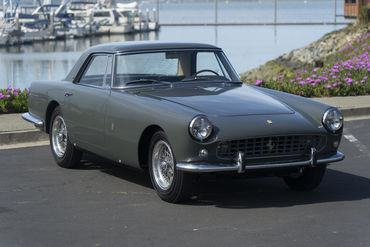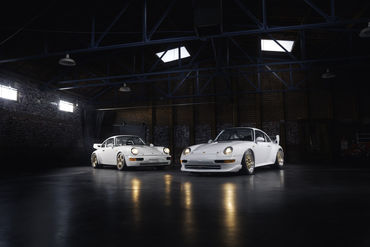Sold
SOLD 12/11
1969 Lamborghini
Miura P400 S
Restored, Rebuilt Engine and Transaxle with Split Sump Conversion. Matching Numbers.
- VIN3814
- Exterior ColorOrange
- Interior ColorNero
- Mileage65569 Kilometers
- EngineDOHC Transverse 4.0L V12
- Engine no.2802
- Transmission5-Speed
- StatusSold
- StockFJ1129
Description
This car is not currently at Fantasy Junction, but can be viewed by appointment.
1969 Lamborghini Miura P400 S
s/n 3814, Engine no. 2802
Orange with Nero Interior
Few cars have stunned like the Miura. Introduced in November of 1965 at the Turin Salon as just a naked chassis, the car created a sensation because of its radical mechanical layout. The sophisticated quad cam V12 was mounted amidships and transversely, creating a compact and balanced platform that went against almost all prior conventions about how to build fast cars. The press was sure Lamborghini was planning a race car, though in reality the car was a hastily conceived exercise to generate publicity. And generate publicity it did. Because of the huge response to the car, Lamborghini decided to build it, though they did not yet have a body. Bertone produced what is surely one of the most beautiful cars ever made and had a prototype ready just four months later, in time to show at Geneva in March of 1966. Orders poured in, and the plan to build perhaps fifty examples was soon scrapped. All told, over seven hundred Miuras would be built, effectively putting Lamborghini on the map, a shocking achievement considering that the firm was just three years old when the Miura was unveiled.
The car was then taken to Monte Carlo for the Monaco GP, drawing crowds five deep, despite the plethora of other exotic cars on hand and the jaded crowd at the casino. Legendary English journalist L.J.K. Setright took the car on a thousand mile tour of Europe for Car magazine, and called it a ‘supercar”, inventing the term that survives with us today to describe a very special automotive experience. The Miura was not dynamically perfect, but invented an entire genre of car and captured everything that was wonderful about motoring in the swinging sixties. Who really needs bumpers or proper rear visibility?
It was all about the colors, the style, the performance, and the noise. The response of the public and the press was almost universally effusive, but there were of course foibles, which in typically Italian fashion, would be ironed out as production proceeded. In November of 1968, the Miura became the Miura S, with the introduction of a number of refinements, including reshaping the combustion chambers, altering the camshafts and carburetion, for about twenty more horsepower. Build quality was improved, electric windows added, and a bit more chrome (on the headlights and window trims) was added. The rear suspension was revised, and on later cars, ventilated discs employed for the brakes.
This particular example is a restored car, with a fresh engine and transaxle rebuild, and conversion to split sump configuration by Bobileff Motorcar Company in 2010. Other work done at this time included the installation of a Halon fire suppression system, upgraded aluminum fuel tank, new Michelin XWX tires, and a majority repaint.
The car makes a fantastic impression. The body is straight with excellent lines and good panel match. The paintwork is very good throughout, with virtually no stone chips, age, or wear evident anywhere. The chromed and painted trim is all excellent, as are the emblems, lenses, and the window glass. The car sits on beautifully restored wheels with correct Michelin XWX tires with matching spare.
The interior is largely original as is in excellent order considering. The dash and switchgear are complete and all in original specification. The headliner is equally nice.
The engine bay is highly correct in equipment and finishes, and is beautifully detailed to show standards. The front clam shell area is equally nicely detailed, and has obviously been carefully restored. The underside, while not detailed for show, displays evidence of the recent work performed, and is generally very solid.
Mechanically, s/n 3418 is an outstanding example. The car starts easily and revs freely with outstanding power and a V12 engine note to die for. The transaxle shifts smoothly, including in and out of second gear (both warm and cold). The brakes are very effective, stopping the car straight, with excellent pedal feel. The suspension is compliant and tight, as would be expected of restored car.
The Miura is the car that changed everything. Its historical significance is formidable because it is one of those rare specific moments that can actually be called a paradigm shift, and it was a truly mind-blowing car in its day. Today, the Miura has aged well. The styling is as gorgeous as ever, and has taken on a surprising sophistication and almost delicacy that is missing from the aggressively assertive supercars of today. Just 149 Miura Ss were built, making them the rarest of the three variants. This particular car, in its vivid orange, is an outstanding representation of this magic period for Italian sports cars.
The above vehicle information is complete and accurate to the best of our knowledge at the time it is posted to this website. Corrections or additional information is always appreciated. All advertised prices exclude government fees and taxes, any finance charges, any dealer document preparation charge, and any emission testing charge. Vehicles are subject to prior sale. All advertised to be true but not guaranteed. We assume no liability for errors or omissions.
Inquire About This Car
Fantasy Junction • 510-653-7555 • 1145 Park Ave, Emeryville, CA 94608





